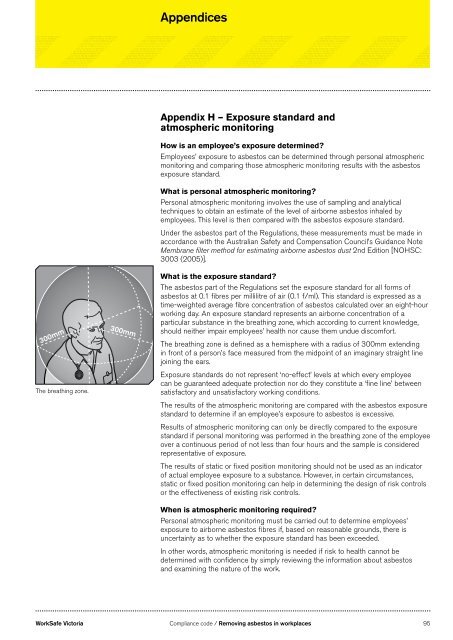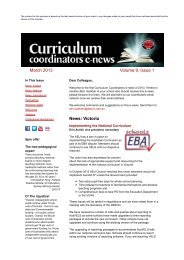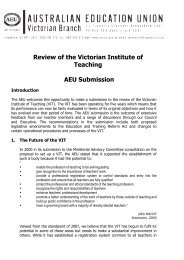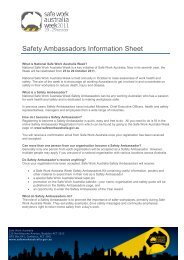Removing asbestos in workplaces - Compliance ... - WorkSafe Victoria
Removing asbestos in workplaces - Compliance ... - WorkSafe Victoria
Removing asbestos in workplaces - Compliance ... - WorkSafe Victoria
Create successful ePaper yourself
Turn your PDF publications into a flip-book with our unique Google optimized e-Paper software.
Appendices300mmThe breath<strong>in</strong>g zone.300mmAppendix H – Exposure standard andatmospheric monitor<strong>in</strong>gHow is an employee’s exposure determ<strong>in</strong>ed?Employees’ exposure to <strong>asbestos</strong> can be determ<strong>in</strong>ed through personal atmosphericmonitor<strong>in</strong>g and compar<strong>in</strong>g those atmospheric monitor<strong>in</strong>g results with the <strong>asbestos</strong>exposure standard.What is personal atmospheric monitor<strong>in</strong>g?Personal atmospheric monitor<strong>in</strong>g <strong>in</strong>volves the use of sampl<strong>in</strong>g and analyticaltechniques to obta<strong>in</strong> an estimate of the level of airborne <strong>asbestos</strong> <strong>in</strong>haled byemployees. This level is then compared with the <strong>asbestos</strong> exposure standard.Under the <strong>asbestos</strong> part of the Regulations, these measurements must be made <strong>in</strong>accordance with the Australian Safety and Compensation Council’s Guidance NoteMembrane filter method for estimat<strong>in</strong>g airborne <strong>asbestos</strong> dust 2nd Edition [NOHSC:3003 (2005)].What is the exposure standard?The <strong>asbestos</strong> part of the Regulations set the exposure standard for all forms of<strong>asbestos</strong> at 0.1 fibres per millilitre of air (0.1 f/ml). This standard is expressed as atime-weighted average fibre concentration of <strong>asbestos</strong> calculated over an eight-hourwork<strong>in</strong>g day. An exposure standard represents an airborne concentration of aparticular substance <strong>in</strong> the breath<strong>in</strong>g zone, which accord<strong>in</strong>g to current knowledge,should neither impair employees’ health nor cause them undue discomfort.The breath<strong>in</strong>g zone is def<strong>in</strong>ed as a hemisphere with a radius of 300mm extend<strong>in</strong>g<strong>in</strong> front of a person’s face measured from the midpo<strong>in</strong>t of an imag<strong>in</strong>ary straight l<strong>in</strong>ejo<strong>in</strong><strong>in</strong>g the ears.Exposure standards do not represent ‘no-effect’ levels at which every employeecan be guaranteed adequate protection nor do they constitute a ‘f<strong>in</strong>e l<strong>in</strong>e’ betweensatisfactory and unsatisfactory work<strong>in</strong>g conditions.The results of the atmospheric monitor<strong>in</strong>g are compared with the <strong>asbestos</strong> exposurestandard to determ<strong>in</strong>e if an employee’s exposure to <strong>asbestos</strong> is excessive.Results of atmospheric monitor<strong>in</strong>g can only be directly compared to the exposurestandard if personal monitor<strong>in</strong>g was performed <strong>in</strong> the breath<strong>in</strong>g zone of the employeeover a cont<strong>in</strong>uous period of not less than four hours and the sample is consideredrepresentative of exposure.The results of static or fixed position monitor<strong>in</strong>g should not be used as an <strong>in</strong>dicatorof actual employee exposure to a substance. However, <strong>in</strong> certa<strong>in</strong> circumstances,static or fixed position monitor<strong>in</strong>g can help <strong>in</strong> determ<strong>in</strong><strong>in</strong>g the design of risk controlsor the effectiveness of exist<strong>in</strong>g risk controls.When is atmospheric monitor<strong>in</strong>g required?Personal atmospheric monitor<strong>in</strong>g must be carried out to determ<strong>in</strong>e employees’exposure to airborne <strong>asbestos</strong> fibres if, based on reasonable grounds, there isuncerta<strong>in</strong>ty as to whether the exposure standard has been exceeded.In other words, atmospheric monitor<strong>in</strong>g is needed if risk to health cannot bedeterm<strong>in</strong>ed with confidence by simply review<strong>in</strong>g the <strong>in</strong>formation about <strong>asbestos</strong>and exam<strong>in</strong><strong>in</strong>g the nature of the work.<strong>WorkSafe</strong> <strong>Victoria</strong> <strong>Compliance</strong> code / <strong>Remov<strong>in</strong>g</strong> <strong>asbestos</strong> <strong>in</strong> <strong>workplaces</strong> 95
















